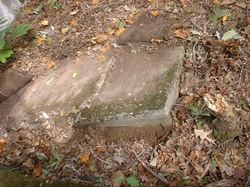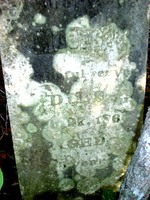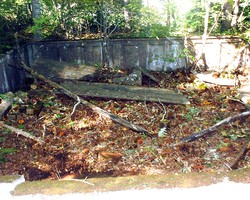The Rutherford Family Cemetery
- - - - - - - - - - - - - - - - - - - - The Rutherford Cemetery - - - - - - - - - - - - - - - - - - - -
The Rutherford Cemetery - Bridgewater, North Carolina
John Rutherford Sr.
To the Memory of John Rutherford, Senr.
A Native of Bedford County Virginia
Born October 5th 1755
Died May 9th 1841
To the Memory of Susanna Rutherford
Departed This Life
29th 1831
in the [broken] ?4th Year of Her Age
A Native of Bedford County, Virginia
To the Memory of Nancy Rutherford
Who departed Oct 17 1868
Jane R. Rutherford
who Departed this Life 24th January 1848
To the Memory of Cecilia Rutherford who Departed this Life 28th July 1847
To the memory of John Rutherford Jr. Born Oct 18th 1789 Died March 18, 1880
The Black Rutherford graves:
In Memory of Hannah Rutherford
Was Born Nov 1st 1803
and Died March 25th 1834
Amy S. Rutherford
Born Dec 4 1834
Died Sept 22 1898
Aged 63y 9m 18d
In Memory of Julius A. Rutherford Son of Silva Rutherford
Died Sept 17th, 1857 Age 4y 8m 12d
To the Memory of Moses Rutherford
A Faithful Servant
Died Feb 27 1860 Aged 63 Years
Memorial of Daniel Webster Rutherford Born Sept 5 1836 Died June 4 1896 Aged 59 Yrs 9 mos
Please see: http://www.findagrave.com/cgi-bin/fg.cgi?page=cr&GScid=2501257&CRid=2501257&pt=Rutherford%20Family%20Cemetery&
Scottish Covenanters were enslaved by the English Anglicans and sent to the West Indies, Barbados and the Carolinas:
"The accounts of their tragic hell ships makes painful reading. Hundreds of these godly men and women, shipped to be sold as slaves, perished in those terrible conditions through disease, and in fearful storms were drowned miserably, battened under hatches. From those who reached the plantations, black slaves heard the Gospel. And thus, white-skinned slave and black rejoiced in one common Lord."
Deuteronomy 23:15-16
“Thou shalt not deliver unto his master the servant which is escaped from his master unto thee. He shall dwell with thee, even among you, in that place which he shall choose in one of thy gates, where it liketh him best: thou shalt not oppress him.”
“Lex, Rex” - Question XIII
by Rev. Samuel Rutherford – Saint of the Covenanters
…….. Slavery of servants to lords or masters, such as were of old amongst the Jews, is not natural, but against nature.
…….. Slavery should not have been in the world.
…….. A man being created according to God's image, he is a sacred thing, and can no more, by nature's law, be sold and bought, than a religious and sacred thing dedicated to God.
…….. Every man by nature is a freeman born, that is, by nature no man cometh out of the womb under any civil subjection to king, prince, or judge, to master, captain, conqueror, teacher, etc.
The Quaker Migration and the Underground Railroad
The Rutherfords were, as was common, intermarried Scots, African Americans and Cherokee. Prior to the civil war, the Rutherfords both black and white, lived together in Burke County, NC without the stereotypical "racial problems". The family is actually tri-racial and, like the descendents of Thomas Jefferson, we are aware and proud of this legacy.
In North Carolina the Rutherfords were part of a social movement which was later called "The Quaker Migration" even though they were not Quakers themselves. The Quaker migration was a massive protest against slavery. Some 50,000 Carolinians left the south and moved to Ohio and Indiana in protesting slavery in the years prior to the Civil War. My family and my wife's family were among them. As more and more restrictive laws concerning African Americans were passed, some Quakers, like Levi Coffin went beyond the Quaker meetings and began to illegally assist blacks fleeing the state. This was the beginning of the "Underground Railroad". Levi Coffin, who became known as the unofficial president of the Underground Railroad, used many freed African Americans, as well as white Americans to assist in moving escaping slaves along the lines from the Carolinas to Canada. It is interesting to find that future president of the United States, Rutherford B. Hayes, offered free legal services to defend slaves in the Cincinnati courts. Rutherford B. Hayes was a Rutherford on his maternal side.
Leaving North Carolina meant my Rutherfords were faced with an unthinkable problem i.e. splitting up the family. Since most white North Carolinians did not sympathize with "the migrants" many took advantage of the migrant's attempts to sell their land and leave. So the "black Rutherfords” stayed in Burke County, NC after their freedom and legal ownership of the Rutherford estates was formalized. The "white Rutherfords” sold what land they could and traded the rest for slaves. These slaves were near kin and friends of the Rutherfords, Hyatts, Birchfields, Dobsons and Leatherwoods of western North Carolina and went to Indiana where they were "given their freedom". This happened in the same way with many other family groups. The communities they founded in Ohio, Illinois and Indiana were the "Canada side stations" of the Underground Railroad. Interesting enough, there is a town called Rutherford College in NC and a township called Rutherford in Indiana.
In Washington County, Indiana, the inhabitants of the Lick Creek Quaker community lived peaceably with a rather large population of Indians and French immigrants. Due to the influx of Quakers, Washington County was divided. The Quakers named the new county after Orange Co. N.C., in which the parent Cane Creek MM was located. And, in the mid 1800's this community became a southern gateway for the famed "Underground Railroad".The first African-American settlers came to Orange County, Indiana shortly before 1820. Slavery was still common in those days. It was even the law in much of the United States at this time. As a matter of fact, the Emancipation Proclamation would not be created for another 40 years! But in 1811 eleven free African-American families from North Carolina were led by a man named Jonathan Lindley to find land on which to live and farm that prohibited slavery. They also did not want to be victims of racial discrimination and harassment anymore. So Lindley and his group settled in Orange County, Indiana and helped to found the Lick Creek Settlement. The settlement is located near Chambersberg, Indiana, which was thought to be a station on the Underground Railroad. It seems that it was the first stop north of the Ohio River. Three African-American families bought land in the Lick Creek area from Quakers in 1832. Less than 20 years later the settlement grew to 1, 557 acres.
Little Africa
In the early 1800's when the Quakers came from North Carolina to settle in Orange County, Indiana, they came to escape slavery. They brought with them a number of freed slaves. These free men were deeded 200 acres of land in the heart of a dense forest. Word of mouth soon spread the news, and this land became part of the "underground railroad" for runaway slaves.
For many years, the black folk in this area farmed, traded, and sold their labor to others while living in this settlement. A church was built and a cemetery was provided for their loved ones.
All that remains today is the cemetery. Some of the stones were broken or vandalized over the years. Several years ago, a troop of Boy Scouts came in and restored the cemetery, replacing the lost or broken stones with wooden crosses designating a grave. The name of "Little Africa" came about because of the black settlement, but "Paddy's Garden" was the name those early residents called it.
The Rutherford Family in Pennsylvania and Illinois
Dr. William Wilson Rutherford
Samuel Rutherford
Samuel Rutherford (1810-1872) was "an earnest opponent of slavery and for many years a member of the Anti-slavery Society of Pennsylvania. The dairy farm where he spent his whole life was part of the original tract purchased by Thomas Rutherford in 1755. Thomas was the progenitor of the Paxtang Rutherfords and a Hunthill Scots-Irishman from Derryloran.
Abner Rutherford
Hiram Rutherford
Dr. Hiram Rutherford was born on December 27th, 1815. He was the son of William and Sarah Swan Rutherford and was raised in Harrisburg, Pennsylvania. His family were active abolitionists and Underground Railroad activists. As a child, his home was a stop on the Underground Railroad and he grew up helping southern slaves travel safely to Canada. As Dr. Hiram Rutherford grew older he began his studies in medicine and worked with his bother Dr. William Wilson Rutherford [see above]. Together they made the long journey from Paxtang, PA to East Central Illinois.
John Rutherford Sr.

John Rutherford Jr.

Moses Rutherford

The Cemetery in Ruins
